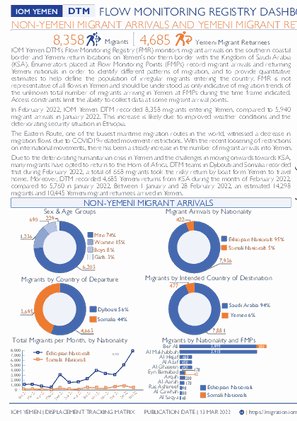-
Countries
-
Data and Analysis
-
Special Focus
-
Crisis Responses
Yemen - Flow Monitoring Points | Non-Yemeni Migrant Arrivals And Yemeni Migrant Returnees In February 2022

Contact
DTM Yemen, iomyemendtm@iom.int
Language
English
Location
Yemen
Period Covered
Feb 01 2022
Feb 28 2022
Activity
- Flow Monitoring Survey
- Flow Monitoring
- Mobility Tracking
IOM Yemen DTM’s Flow Monitoring Registry (FMR) monitors migrant arrivals on the southern coastal border and Yemeni return locations on Yemen's northern border with the Kingdom of Saudi Arabia (KSA). Enumerators placed at Flow Monitoring Points (FMPs) record migrant arrivals and returning Yemeni nationals in order to identify different patterns of migration, and to provide quantitative estimates to help define the population of irregular migrants entering the country. FMR is not representative of all flows in Yemen and should be understood as only indicative of migration trends of the unknown total number of migrants arriving in Yemen at FMPs during the time frame indicated. Access constraints limit the ability to collect data at some migrant arrival points.
In February 2022, IOM Yemen DTM recorded 8,358 migrants entering Yemen, compared to 5,940 migrant arrivals in January 2022. This increase is likely due to improved weather conditions and the deteriorating security situation in Ethiopia.
The Eastern Route, one of the busiest maritime migration routes in the world, witnessed a decrease in migration flows due to COVID19-related movement restrictions. With the recent loosening of restrictions on international movements, there has been a steady increase in the number of migrant arrivals into Yemen.
Due to the deteriorating humanitarian crisis in Yemen and the challenges in moving onwards towards KSA, many migrants have opted to return to the Horn of Africa. DTM teams in Djibouti and Somalia recorded that during February 2022, a total of 668 migrants took the risky return by boat form Yemen to travel home. Moreover, DTM recorded 4,685 Yemeni returns from KSA during the month of February 2022, compared to 5,760 in January 2022. Between 1 January and 28 February 2022, an estimated 14,298 migrants and 10,445 Yemeni migrant returnees arrived in Yemen.
The migrant caseload was 95 per cent Ethiopian, and five per cent Somali. The migrants are predominantly male (74%), with (15%) women, eight per cent boys and three per cent girls also among the travelers.
Through February reporting period, 3,695 migrants arrived from Somalia and were recorded 3,275 at Ber Ali, 220 at Eyn Bamabad, and 200 at Arqah flow monitoring points in Shabwah governorate. In Lahj governorate saw the highest number of migrant arrivals, with 4,663 migrants arriving from Djibouti were recorded 2,915 at Al Makhabah, 460 at Al Hejaf, 450 at Al Azaf, 450 at Al Ghaseen, 170 at Al Aarah, 98 at Ras Ashareef, 80 at Al Cawhah, and 40 at Al Saqya flow monitoring points.
METHODOLOGY:
DTM’s global flow monitoring methodology aims to identify areas prone to internal, cross-border and regional migration. Mobility area assessments are conducted at the national level. DTM teams then collect information at the local level to identify key transit points. Enumerators collect data from key informants at the flow monitoring points: key informants may be transport staff, custom officers, boat operators or migrants themselves. Data is collected through a basic form combined with direct observations –enabling breakdowns.
LIMITATIONS:
Data collected for these exercises should be understood as estimations only. They represent only part of the total flows passing through Yemen. The spatial and temporal coverage of this data collection activity is therefore incomplete. In addition, although data is collected daily, it is collected only during peak hours. The portion of the flows that occur during the uncovered hours is not represented. Data on vulnerability is based on direct observation and should be understood as mainly indicative.
